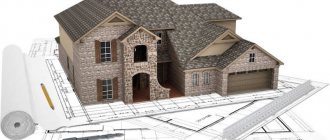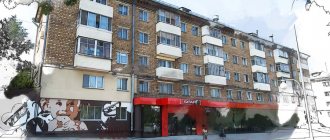Non-residential real estate - what is it?
There is no precise definition of this concept in the legislation. But in practice, it is generally accepted that non-residential premises are not intended for permanent residence . But this does not apply to him:
- Residential premises recognized as unsafe.
- Common property of residents of an apartment building (for example, an elevator, stairs, attic, entrance, basement).
It is part of the building. In some cases, a certain building may have one room, then they coincide. Non-residential premises can be located in residential buildings (intended to be lived in) or completely non-residential.
Important! If certain conditions are met, the housing stock can be converted to non-residential.
The reverse transition is also possible, but it is even more difficult.
What premises cannot be used as housing stock?
From the point of view of the law, the emergence of the legal status of residential premises in a non-residential building is excluded. According to the legal definition of the term “residential premises,” one of its immediate features is the presence of registered citizens living in its area. Non-residential real estate, on the contrary, cannot be legally recognized as a place of residence. Therefore, it is legally impossible to register there. This will be the main difference between non-residential and residential buildings.
This rule has been established. However, if a citizen has arbitrarily occupied non-residential premises that belong to him by right of ownership for the purpose of living, no one has the right to evict him from there, but in this case administrative liability may be imposed for lack of registration. To date, the law does not provide for the status of residential premises in a non-residential building.
Sources
- https://sudsoveti.ru/pomeshheniya-zhilye-i-nezhilye-chto-eto-takoe-i-dlya-kakih-czelyah-podhodyat-razbiraemsya-s-umom/
- https://svoe.guru/nezhilaya-sobstvennost/otlichie-ot-zhilogo-zhilya.html
- https://prodatkvartiry.ru/kommercheskaya-nedvizhimost/razberem-zhiloe-i-nezhiloe-pomeshhenie-ili-kvartiru-v-chyom-raznica/.html
- https://urexpert.online/nedvizhimost/nezhilaya/otlichiya-ot-zhiloj.html
- https://leonmonitor.ru/chem-otlichaetsja-zhiloe-pomeshhenie-ot-nezhilogo/
- https://pravosudie.guru/nedvizhimost/nezhilaya/otlichiya-ot-zhiloy.html
- https://prokvartiru.com/oformlenie/nezhiloe/zhilie-i-nezhilie-pomescheniya
Signs
The main features include the following:
- Such an object is real estate.
- Not intended for people to live in.
- It is isolated, that is, separate. The boundaries of the room are building structures, that is, walls, floors, ceilings, etc.
- There must be a separate entrance.
- The premises must be registered on a specific site.
- It must be impossible to move it.
- It must comply with building, fire and technical standards.
The advantages of NEOs include:
- Complete absence of neighbors.
Having such a building you will be your own master;
- Possibility to organize your own parking spaces on the territory adjacent to the OSZ for parking visitors’ vehicles.
Of course, if the free area of land for the NEO allows.
- A very important advantage of NEOs is the presence of their own communications.
Since in other types of buildings, communications are common throughout the building and are usually connected to other rooms.
This threatens that your utility bills will be inflated and you will not be able to do anything.
After all, all losses of water and electricity, even those that occurred through no fault of your own.
Will be extended to all owners of premises that have twin communications.
That is, the neighbors will have a leak, and all non-residential premises connected by communications will pay.
But the main advantage of the NEO is also its disadvantage.
What objects belong to this category of buildings and structures?
Such real estate is divided into:
- main;
- and auxiliary.
The first can be used separately, and the second is needed for maintenance and use of other premises. For example, a school office is the main room, and the corridor is an auxiliary room.
also a division according to intended purpose . In accordance with it, premises can be:
- Educational (these include buildings of kindergartens, schools, universities, etc.).
- Healthcare (for example, hospitals, clinics, emergency rooms).
- Industrial.
- Administrative.
- Utilities (gas, water, electricity, heat supply).
- Catering.
- Household services (these include studios, laundries, dry cleaners, repair shops and others).
- Trade.
- Relaxation and entertainment.
- Post offices (post offices).
- Warehouse.
- Creative (workshops and exhibition halls).
What are non-residential properties used for?
Non-residential premises are used for various commercial and public purposes. They house organizations offering and providing a variety of services.
The purpose of such places is directly related to their classification. According to the functional isolation of non-residential places, they are distinguished:
- The main ones, for example, are the halls and offices in which the activities of the enterprise are carried out.
- Auxiliary (service) premises: corridors, vestibules, staircases, other common areas.
The following premises are created according to the actual purpose or purpose of use:
- for trade (shops, shopping centers);
- for production purposes;
- for a warehouse;
- to maintain communication through branches;
- for places of consumer services;
- equipped as a garage;
- for administrative purposes (government institutions);
- for the placement of catering establishments;
- related to educational and scientific activities;
- for medical and sanitary purposes (hospitals);
- for public utilities (supply of water, gas, electricity);
- for services in household areas (ateliers, dry cleaners, repair shops);
- cultural, entertainment and development places (exhibition halls).
Each such category is detailed into narrower objects, which is prescribed at the discretion of the parties.
The intended purpose of the rented non-residential premises is determined by the conditions of use of the transferred property and the parties to the transaction.
What a non-residential place is suitable for is determined only by the parties to the transaction. The above objectives are indicated when drawing up the lease agreement.
Note. According to Article 615 of the Civil Code of the Russian Federation “Use of leased property,” the property is used in accordance with the terms of the agreement or its purpose.
Is it possible to convert non-residential premises into residential premises?
This is a question that owners often ask when they want to redevelop their existing property for the place in which they plan to live. Also, people who have purchased a residential property sometimes think about turning it into an area for carrying out their activities.
Let's deal with the first situation. You have the right to convert non-residential property into residential property. But to do this, you meet a number of conditions:
- As the owner of the premises (tenants are not allowed), you draw up an application to change the status of the property. If there are several owners, then written consent of all parties is required.
- Make sure there are no debts on utility bills.
- The property must not have any encumbrances, for example, be pledged.
- Everything complies with existing safety standards and has connections to all utilities.
- When transferring from one type to another, no actions are taken that bring danger to residents of nearby residential premises.
- Instead of a separate entrance, free access through a common entrance is required.
To complete such a process, you will need a redevelopment plan. The owner also collects all documents for the premises (technical passport, floor plan and redevelopment scheme).
Along with the application, the owner submits them to the architectural department of the city administration. The review procedure takes about 45 days.
If you have given consent, repairs begin. After completion of the work, an inspection is carried out by specialists from the technical inventory bureau.
Then you receive new documents for the premises and apply with them to Rosreestr or MFC to obtain a certificate of title to the new property.
Property requirements
The property must meet the following requirements:
- There must be a separate entrance or the ability to arrange one.
- There are certain requirements for the location: on the ground floor or above a non-residential premises.
- It should not be used for permanent residence or interfere with the overall architectural appearance of the house.
- There are no third party rights or any encumbrances.
- Also, it should not form part of the living space. For example, you cannot transfer part of an apartment or room in a communal apartment.
Attention! If such real estate can be used only with the annexation of part of the common space of an apartment building, the consent of the residents will be required. To obtain it, you will need to hold a general meeting.
Permission will also be required to organize a separate entrance if this requires changing the enclosing and/or supporting structures.
Further use must comply with the following requirements :
- sanitary and hygienic;
- fire protection;
- environmental.
In particular, if non-residential premises are located in a residential building, the following cannot be placed in it :
- Enterprises that pollute the territory and air (physically and chemically).
- Violating living conditions.
- Some treatment and preventive organizations (helping with drug and alcohol addiction, infectious patients).
- Industrial enterprises.
- Stores selling chemical, explosive or other dangerous goods.
- Dry cleaners.
- Public toilets.
- Institutions operating later than 11 pm (or, moreover, around the clock).
What are these buildings?
The current legislation of the Russian Federation does not provide a clear explanation of the terms “purpose of premises” and “functional purpose of premises”.
Reference! According to sub. 3 clause 36 of block 3.5 of the procedure for maintaining the Unified State Register of Real Estate, approved by order of the Ministry of Economic Development of the Russian Federation dated December 16, 2015 No. 943, there is a division of all premises into two types: non-residential and residential.
The provisions of the Unified State Register determine the types of permitted use of a particular object. Previously, the functional purpose of a non-residential building was necessarily indicated in the design documentation. But at present, the Law “On Participation in Shared Construction” dated December 30, 2004 No. 214-FZ no longer contains a mandatory requirement to include in the information about a construction project information about the functional purpose of non-residential buildings that do not belong to common property.
The Civil and Housing Code of the Russian Federation, as well as Federal Law of the Russian Federation No. 218 dated July 13, 2015, provide the main criteria for non-residential premises, which also meet the requirements for a residential building, namely:
- The object must be immovable and isolated, its boundaries are the floor, ceiling, walls.
- There must be an entrance to such a building.
- The immovable nature of the object is due to the fact that it is part of a building located on a specific plot of land.
- It can also be located in residential and non-residential buildings, but the premises themselves must be classified as non-residential.
The main difference between a non-residential property and a residential one is that it does not provide for permanent residence of people, and also that it is allowed to be used only for administrative, public, commercial and other purposes.
Most citizens do not distinguish between the legal status of common property and non-residential premises. The entrance, attic, elevator and basement are considered common areas. Non-residential premises in apartment buildings include cafes, shops, offices and other organizations. A special place is occupied by domestic non-residential premises in which there are studios, shops, and social welfare institutions.
Administrative buildings are structures united by a common architectural task, the main purpose of which is to create conditions for the functioning of the administrative apparatus of state, municipal and private enterprises, institutions and organizations.
Differences from premises for permanent residence
The main difference is the purpose. Residential premises are intended for living, and non-residential premises are intended for other purposes. This could be trade, provision of services, production, etc.
An additional feature will be the presence (or absence) of a separate entrance. The location on the floor in an apartment building is also important.
Examples of what belongs to the residential stock and what to non-residential. The residential stock includes :
- apartments of an apartment building, including communal ones;
- separate houses intended for permanent residence;
- dormitories.
Classified as non-residential:
- the shops;
- dry cleaners;
- Beauty Salons;
- hotels (since they are intended for temporary residence, not permanent);
- apartments.
So, non-residential premises include separate premises not intended for living. They can be of different types according to their purpose and used for different purposes, and must also meet a number of requirements.
Features of transactions related to non-residential premises
Transactions related to non-residential real estate are similar to ordinary ones, but they have a number of nuances.
When registering non-residential buildings, owners receive certain rights to them, adhering to the conditions specified in the contract. Registration is mandatory because it gives the right to legally use the place for commercial or public purposes.
The contract is considered concluded only from the moment of registration. All obligations regarding the transfer of objects under the purchase and sale agreement are also fulfilled. This is officially recorded in legal documents.
Important. The seller of the property has the right of ownership to it - a necessary condition for concluding a transaction.
As a rule, the seller notifies the buyer about the condition of the non-residential premises and the possible costs of correcting its deficiencies. Information about the rights of third parties to real estate is also not hidden when completing a transaction.
Often, it is not important for the parties for what purposes the premises will be rented, the main thing is that it is not intended for living. Under such conditions, the contract briefly states: “Non-residential premises for rent.”
The parties indicate the purpose of use depending on the classification (administrative, commercial, industrial premises).
✨ Summary
To sum it up:
- In order to transfer a bathhouse into a residential building, it must meet a number of requirements, in particular, it must comply with engineering and safety standards - or be able to undergo appropriate conversion.
- A bathhouse and a residential building have fundamental functional, sanitary, and legal differences - all this is prescribed by law.
- To document the transfer of a bathhouse to a residential building, you need to collect a package of documents and submit them to the MFC or local government authority.
Drilling a well on the site – whether to obtain a license or not. Legislative norms governing water intake for personal use
Read
What buildings can be erected on the site without breaking the law. We analyze the types of structures and responsibility for self-construction
More details
How to build a toilet in your country house without quarreling with your neighbors. Distances, levels and other rules by law
Look
Where to go for translation
Today, the procedure for submitting documents in many regions has been simplified thanks to Multifunctional Centers that operate on a one-stop-shop principle. In one place you can submit all documents, in some cases, order certificates and receive the corresponding document after all procedures are completed.
You will need with you:
- Application for transfer;
- Documents that confirm your right of ownership;
- Documents from the BTI: technical plan, technical passport, floor plan of the house;
- If, when changing the status, some kind of redevelopment is necessary, you are also required to provide a design for it.
You must find out whether you can transfer your premises to another fund or not within 45 days. This is how long it takes to review the application and check the documents provided.
Once the decision is made, the authorized bodies have three days to notify you of their consent or refusal. The relevant paper can be sent by mail or sent to the Multifunctional Center.
A notification can also be sent to your email.







